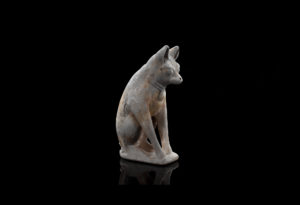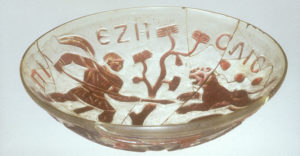
Kantonsarchäologie Schaffhausen / Rolf Wessendorf
Glass vessels for eternity
A drinking bowl from Stein am Rhein is among a trove of precious glass finds dating from the Roman era. The piece itself is spectacular, but the circumstances of its discovery are just as remarkable.
In September 1969, when laying heating pipes in the greenhouse of a market garden situated next to the railway line from Stein am Rhein to Kreuzlingen, a workman came across two skeletons and a fragment of a glass bowl decorated with a motif of figures in relief. He had discovered the necropolis of the Late Roman fortress of Auf Burg, which lay about 250 metres to the north. Since then, several excavations have uncovered a total of 83 graves. The quality and the number of grave goods made of glass, as well as the comparatively intact context of castle and associated burial ground, are what make the site so special. The archaeological fieldwork will be completed this year. Results of the examination of the old and new finds using the new methods of aDNA research are eagerly awaited.
Rescue excavation in the greenhouse
The gardener, who was familiar with inhumation burials, realised straightaway that the skeleton discovery was something special. With the Canton archaeologist away at the time, local art historian Hildegard Urner-Astholz and policeman Ruedi Studer handled the matter. They arranged for the excavated soil which had already been transported to a landfill site, to be sifted through, and managed to find further fragments of the bowl. The subsequent rescue excavation uncovered six more graves containing precious glass items. The circumstances of the find are remarkable above all because a fragment of what was by far the most important piece came to light immediately.
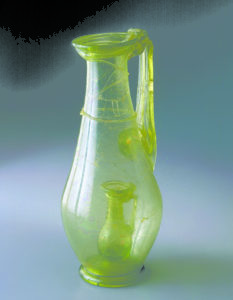
The glass jug with inner jug, thought to have been made in a factory in Cologne in the early 4th century, is a masterpiece of the glassblower’s art.
Kantonsarchäologie Schaffhausen / Rolf Wessendorf
The priceless ceremonial bowl holds about quarter of a litre of wine mixed with water. It’s when in use that the vessel unfolds its full magic; when filled with white wine, the light catches the glimmering, slightly viridescent glass and makes the reddish-brown figures glow. Only a high-ranking official of the Roman provincial administration would actually be likely to have owned the sumptuous vessel. This magnificent glass item would have been used on solemn occasions, with funeral banquets being a notable example.
The use of the bowl as a burial object and the motifs depicted on it are a reference to the belief in immortality. Both the Greek inscription ‘PIE ZESAIS – Drink, live long!’, and the two hunting scenes with the pine tree representing the tree of life, belong to the context of this World and the Afterworld. The inscription is ambiguous. It is found in Latin and in Greek versions on various drinking vessels, inter alia on Late Roman wine cups from the Rhineland. The set phrase on these wine cups is, of course, first and foremost a toast along the lines of the Latin ‘Prosit!’ or the equivalent ‘Your health’. But it is also found on grave goods and in particular on the gold leaf tablets that, in the 4th century BC, were buried with the dead in the Orphic-Pythagorean regions of southern Italy, including precise instructions for the journey through the Underworld to the Islands of the Blessed. On the gold tablets, the phrase ‘Drink, live long!’ refers not to wine, but to the life-giving water from the Fountain of Memory, the Mnemosyne, which according to the beliefs of antiquity was located directly adjacent to the Fountain of Forgetfulness, the Lethe. So the utmost caution was required on the path to eternity. The water symbolises not only remembering and forgetting, but also life and death.
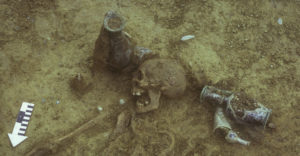
Uncovered in 1974, this grave in Stein am Rhein contained a particularly rich array of glass items.
Kantonsarchäologie Schaffhausen / Rolf Wessendorf
Virtue and immortality
According to the beliefs of antiquity, immortality was achieved by heroic bravery, the first of the Roman cardinal virtues. This is exemplified by deeds such as one-on-one battle with wild animals – not in the arena, but in the animals’ natural habitat. The two artistically balanced hunting scenes on the drinking bowl, limited in their depiction to the bare essentials, show two young men whose clothing and attributes identify them as aristocrats, fighting a panther and a bear respectively. The round shield of the hunter, who is thrusting his spear at the pouncing panther using his left hand which, for safety’s sake, is held fairly far back, lies on the ground at his feet. This is another indication of his bravery, and also of his noble pedigree, because the round shield is not only a protective weapon but also a status symbol reserved for the most distinguished Roman citizens.
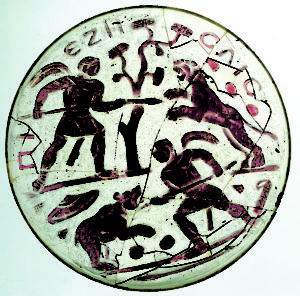
The Jagdschale from Stein am Rhein is one of the highlights of the permanent exhibition of the Museum zu Allerheiligen in Schaffhausen.
Kantonsarchäologie Schaffhausen / Rolf Wessendorf
Late roman fortress
The Late Roman fortress with its twelve towers, built under the Emperors Diocletian and Maximian around the year 294, guarded the borders of the Empire which had been moved back to the Rhine, the Danube and the Euphrates as part of a wide-ranging military and administrative reorganisation. The imposing edifice got its name from the adjacent Gallo-Roman settlement, the vicus of Tasgetium (Eschenz). The remains of the fortress walls, with its corner towers precisely aligned to the four cardinal points of the compass, can still be seen today.
In the Middle Ages places with Roman ruins were often given the name ‘Burg’, meaning a castle or fortress – this was also the case in other linguistic regions, Luxor (Arabic al-quasr, from the Lat. castrum) on the Nile being a good example – so that to this day the hill with the former fortress is still called Auf Burg. The Tasgetium fortress included a stone bridge over the Rhine and a well-developed bridgehead on the right bank of the Rhine, which was only found in 1986 in excavations beneath the St George’s abbey complex. The situation at Tasgetium thus corresponds to that in Zurzach and Kaiseraugst, the other two locations of Late Roman fortresses and Rhine crossings between the outflow of Lake Constance and the Rhine knee at Basel. We know little about the composition of the population in the area of the fortress, which was densely populated for three or four generations. The graves of women and children in the necropolis and the abundant grave goods suggest that not only 100 to 200 soldiers, but also scores of civilians lived within the fortress walls. Shortly after the year 400, the base was abandoned by the Roman military administration, which doesn’t mean the area was no longer inhabited.
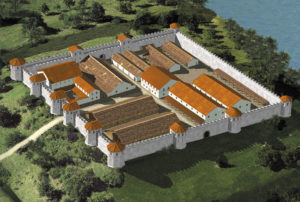
Computer reconstruction of the Tasgetium fortress. The necropolis was about 250 metres away on the road leading to the fortress.
Kantonsarchäologie Schaffhausen / Valentin Homberger
Roman viticulture in north-eastern Switzerland?
Where did the wine that was drunk, on ceremonial or festive occasions, from the luxury glass vessels found in Stein am Rhein actually come from? In amphorae from Italy and southern France and in wooden barrels from the growing regions in the Alpine valleys of Rhaetia, and probably also on the Rhine and Moselle. Both amphorae and parts of wooden barrels were found in the adjacent vicus of Tasgetium. The names of wine dealers and coopers can even be read on branding stamps and incised markings. Of particular interest is the stamp of a merchant with the Rhaetian surname Suans. It is probable that wine was produced on the nearby Roman estates for everyday personal requirements.
Along with grain, oil and salt, wine was the most important foodstuff. But concrete archaeological evidence of local viticulture is still lacking today. Neither parts of wine presses, nor grape knives or drinking paraphernalia have been found. Unlike the walnut tree, no evidence has been found of grapevines. Not even grape seeds have appeared in the excavations in latrines and wells.



